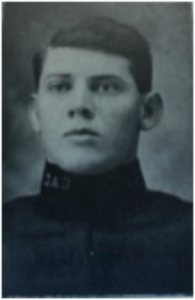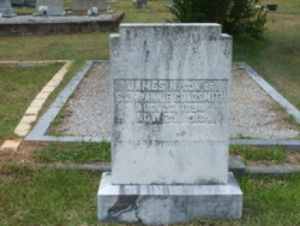Scroll of Honor – James Goldsmith
Germ Warfare
The biggest killer in 1918 wasn’t the Great War, as the First World War was known at the time.  In fact, the war, with all of its attending miseries, was a distant second—a very distant second.
In fact, the war, with all of its attending miseries, was a distant second—a very distant second.
James Goldsmith was a Greenville boy who enrolled at Clemson College as a member of the Class of 1914. Goldsmith and his fellow cadets lived in the original barracks lined up behind the Main Building and its clock tower. Johnstone, Lever, Tillman, Donaldson, Wannamaker, Bradley and Manning were the College’s life trustees. The youthful Walter Merritt Riggs was the College president and taught a Bible class, as did English professor D. W. Daniel. We don’t know much about Goldsmith’s campus experience, but we do know that by 1918, he had enlisted in the Army and was training at the officer training school at Camp Hancock in Augusta, Georgia.
Before Goldsmith could complete his training, the war ended with the November 11 armistice and the doughboys began returning home—but they were not alone.
An outbreak of influenza had occurred in the spring of that year. It was first identified at Army posts around the country. The movements of large formations of soldiers across the country and across the sea helped spread the flu virus, but it was a second, more virulent wave of the disease that struck the hardest. The first outbreaks were noted in September, in Boston, where shipments of men and war supplies kept the harbor full of traffic. Soldiers, sailors and merchant seamen packed into the tight confines of ships carried the flu germs into the city and to wherever their cargo was bound. Within weeks, the illness was spreading across the United States and with devastating effect.
It was often referred to as the Spanish Flu, but its origins in Spain are doubtful. Spain, a neutral in the war, had no press censorship and so cases of the flu—including the illness of the King—were widely reported. The United States, Great Britain, France and Germany, as belligerents, suppressed reports of the growing pandemic due to fears of the effect such news would have on the morale of peoples at war.
In October, more than 200,000 Americans died from the flu. The end of the war on November 11 led to widespread celebrations—parades, parties, worship services—that brought thousands of people into close proximity creating ideal conditions for the disease to spread. In stark contrast to earlier strains of the flu, the segment of the population hardest hit was those between the ages of 24 and 35 years of age. Researches hypothesized that the flu triggered an overreaction of the body’s immune system. Ironically, the stronger defensive reactions of young adults ravaged their bodies. The weaker immune systems of children and middle-aged adults resulted in fewer deaths.
The pandemic, which would rage across the globe into 1919, killed between twenty and forty million, far  more even than the infamous Black Death Bubonic Plague of the mid-1300s. Twenty-eight percent of Americans fell ill and 675,000 died, including James Goldsmith.
more even than the infamous Black Death Bubonic Plague of the mid-1300s. Twenty-eight percent of Americans fell ill and 675,000 died, including James Goldsmith.
Goldsmith, who just eighteen months earlier had wed, died on November 29, less than three weeks after the end of the War to End All Wars. He is buried at Rose Hill Cemetery in Piedmont.
The effect of the influenza epidemic of 1918-19 was so severe that it dropped the average life span in the United States by ten years.
For more information on James Goldsmith see:
For additional information on Clemson University’s Scroll of Honor visit:
